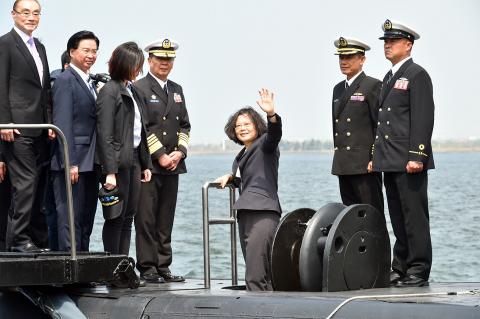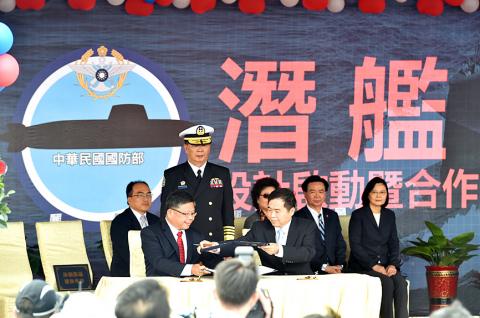The nation is hoping to build its first homegrown submarines within eight years and commission them into service within a decade, the shipbuilder tasked with carrying out the program said yesterday.
CSBC Corp, Taiwan (台灣國際造船) chairman Cheng Wen-lung (鄭文隆) said there were problems that needed to be worked out because Taiwan lacks experience in building submarines, but added that the difficulties were being addressed.
CSBC, the nation’s only listed shipbuilder, has built more than 100 ships for the navy and will use that experience in developing the local submarine program, he added.

Photo: Chang Chung-i, Taipei Times
Cheng’s comments came as CSBC and the Chungshan Institute of Science and Technology signed a memorandum of understanding (MOU) with the navy earlier yesterday in Kaohsiung to jointly build submarines for the military.
The project is part of a broader initiative to develop an independent national defense industry.
The project will have two main phases, the MOU said.

Photo: Chang Chung-i, Taipei Times
The first will be to complete the design for the submarines and will have a budget of about NT$2 billion (US$65.66 million), Cheng said.
The second stage will involve building the submarines, he said, without giving any cost projections for the vessels or estimates of how many submarines would be built.
According to the schedule, the indigenous submarines are to be completed within eight years and then commissioned into service within a decade, he said.
Cheng was asked about the planned submarines’ design and whether it would be based on the designs of existing submarines in the navy’s fleet, which were purchased from the US in the 1970s and the Netherlands in the 1980s.
“The design will be based on a model that meets the needs of Taiwan’s self-defense,” he said.
Institute vice president Gao Chung-hsing (杲中興) said that the most important part of the program is building a system that integrates all equipment and ensures the safety of ships operating underwater.
The institute will cooperate with CSBC in these areas, Gao said.
Yesterday’s signing was also witnessed by President Tsai Ing-wen (蔡英文), who said the construction of submarines is the most challenging aspect of the nation’s policy to create an independent national defense industry.
The government will exhaust all means and pool its resources to solve any problems associated with building the submarines, she said.
Minister of National Defense Feng Shih-kuan (馮世寬) also attended the signing ceremony, which was preceded by the formal send-off of a fleet of navy vessels on a training mission that will include goodwill visits to some of the nation’s diplomatic allies.
During the ceremony, Tsai boarded the Hai Lung-class submarine the Hai Hu in Zuoying Military Harbor to watch a simulation of a torpedo launch.
Taiwan has long tried to acquire submarines from other countries with little success because of their reluctance to upset China.
In 2001, then-US president George W. Bush authorized the sale of eight diesel-electric submarines to Taiwan, but the deal never came to fruition because of political wrangling in Taiwan and questions over whether the US, which did not produce conventional submarines at the time, could supply the vessels.

The combined effect of the monsoon, the outer rim of Typhoon Fengshen and a low-pressure system is expected to bring significant rainfall this week to various parts of the nation, the Central Weather Administration (CWA) said. The heaviest rain is expected to occur today and tomorrow, with torrential rain expected in Keelung’s north coast, Yilan and the mountainous regions of Taipei and New Taipei City, the CWA said. Rivers could rise rapidly, and residents should stay away from riverbanks and avoid going to the mountains or engaging in water activities, it said. Scattered showers are expected today in central and

COOPERATION: Taiwan is aligning closely with US strategic objectives on various matters, including China’s rare earths restrictions, the Ministry of Foreign Affairs said Taiwan could deal with China’s tightened export controls on rare earth metals by turning to “urban mining,” a researcher said yesterday. Rare earth metals, which are used in semiconductors and other electronic components, could be recovered from industrial or electronic waste to reduce reliance on imports, National Cheng Kung University Department of Resources Engineering professor Lee Cheng-han (李政翰) said. Despite their name, rare earth elements are not actually rare — their abundance in the Earth’s crust is relatively high, but they are dispersed, making extraction and refining energy-intensive and environmentally damaging, he said, adding that many countries have opted to

SUPPLY CHAIN: Taiwan’s advantages in the drone industry include rapid production capacity that is independent of Chinese-made parts, the economic ministry said The Executive Yuan yesterday approved plans to invest NT$44.2 billion (US$1.44 billion) into domestic production of uncrewed aerial vehicles over the next six years, bringing Taiwan’s output value to more than NT$40 billion by 2030 and making the nation Asia’s democratic hub for the drone supply chain. The proposed budget has NT$33.8 billion in new allocations and NT$10.43 billion in existing funds, the Ministry of Economic Affairs said. Under the new development program, the public sector would purchase nearly 100,000 drones, of which 50,898 would be for civil and government use, while 48,750 would be for national defense, it said. The Ministry of

UNITED: The other candidates congratulated Cheng on her win, saying they hoped the new chair could bring the party to victory in the elections next year and in 2028 Former Chinese Nationalist Party (KMT) lawmaker Cheng Li-wun (鄭麗文) yesterday won the party’s chair election with 65,122 votes, or 50.15 percent of the votes. It was the first time Cheng, 55, ran for the top KMT post, and she is the second woman to hold the post of chair, following Hung Hsiu-chu (洪秀柱), who served from 2016 to 2017. Cheng is to succeed incumbent Eric Chu (朱立倫) on Nov. 1 for a four-year term. Cheng said she has spoken with the other five candidates and pledged to maintain party unity, adding that the party would aim to win the elections next year and